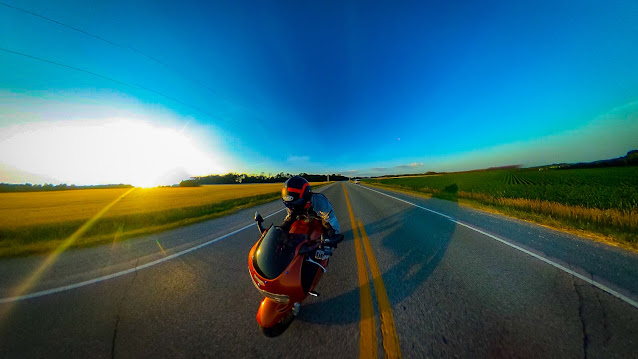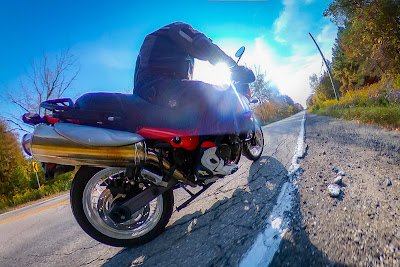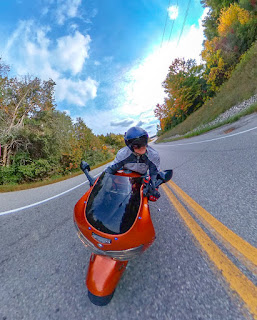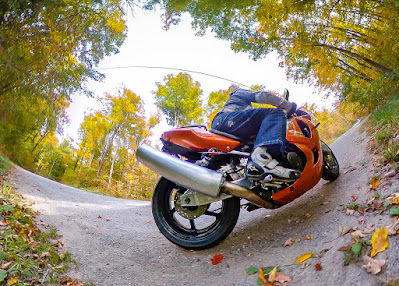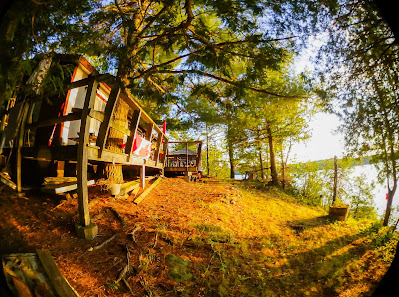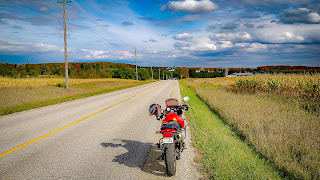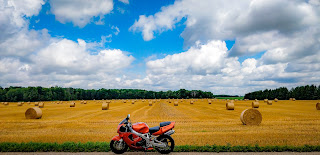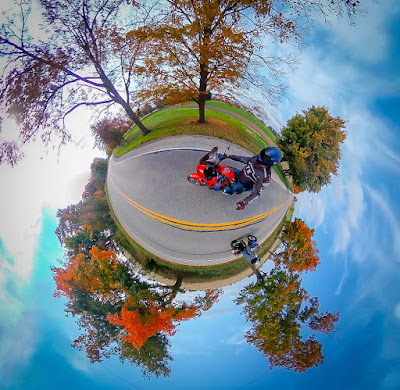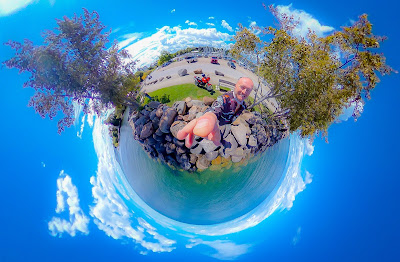Just bumped into another Dad from my street who no longer comes out to get his kids on the other school bus in the morning. He told me a sad story.
Machine Learning
’97 CBR900RR LED Indicators and Rubber Parts
The Fireblade project has the main bits (fuel leak leading to an engine drowned in gasoline) fixed with a carb rebuild and a new petcock. But there are lots of bits and pieces to sort out before I go get it safetied and put on the road.
 The weather warms up tomorrow so I’m hoping for a ride, but Saturday was a -20° March 7th kinda day, so into the garage I went to get the little details worked out.
The weather warms up tomorrow so I’m hoping for a ride, but Saturday was a -20° March 7th kinda day, so into the garage I went to get the little details worked out.
I was initially going to hold off on the LED indicators, but dead bulbs and broken covers on a 23 year old motorcycle meant the LEDs were actually the cheaper, easier and more modern looking fix anyway. I’d brought a second set when I got the ones for the Tiger, and also got an adjustable indicator relay, so I had all the parts on hand.
The rear indicators look like they were attached by a monkey. I ended up pulling them all off and removing all the stripped, half installed wood screws that were holding them in. I then drilled a hole in the rear plastic under-tray and mounted the second set of LEDs I had on hand from the Tiger upgrade.

The wiring was pretty straight forward with green being ground on both indicators (connected to black on the LED) an orange to LED power (yellow) on one side and light blue to LED power (yellow) on the other. The LEDs also have brake light function where they strobe when you first press the brake. Both red cables on the LEDs go together into the middle pin on the brake lights. It works a trick:
Front LED indicators working: https://photos.app.goo.gl/4psz7VfHg6mLnvcK6
Rear indicators working with brakes: https://photos.app.goo.gl/AKJeo69DCpV4gzGAA
***
Some other odds and ends are also proving troublesome. Living in rural Canada means everyone’s still in love with imperial sized fasteners. All our local hardware stores have rows of ’em, and maybe 2 metric bolts. It was tricky figuring out the sizes of missing fasteners anyway, but some internet research into OEM parts supplier parts listings got me this far:

https://www.megazip.net/zapchasti-dlya-motocyklov/honda/cbr900rr-14743/cbr900rr-cbr954rr-fire-blade-28645/cbr900rrv-713455
Bolts to hold down the fuel tank:
96300-0604007
Bolt, flange (6×40)
Other metric sized bolts in the same assembly:
BOLT, FLANGE (6X20)
https://www.cmsnl.com/honda-cbr900rr-fireblade-1997-v-canada_model2523/bolt-flange-6x32_960010603200/#.Xlvt-KhKiHs
BOLT, FLANGE, 6X32 CBR900RR FIREBLADE 1997 (V) CANADA
![]() A 6×40 metric bold means (as I understand it) a 6mm wide bolt that is 40mm long. But metric sizing also looks like M6x40. I’m assuming their the same but don’t understand why there isn’t a consistent format for metric bolt sizing.
A 6×40 metric bold means (as I understand it) a 6mm wide bolt that is 40mm long. But metric sizing also looks like M6x40. I’m assuming their the same but don’t understand why there isn’t a consistent format for metric bolt sizing.
Some other resources around motorcycle fasteners:
https://www.cmsnl.com/honda-cbr900rr-fireblade-1997-v-canada_model2523/partslist/#.XlvtcahKiHs
https://www.webbikeworld.com/motorcycle-nuts-bolts-fasteners/
Lots of links to other websites.
https://www.boltdepot.com/fastener-information/Type-Chart.aspx
The bolts into the frame that hold down the fuel tank and the brace for the windshield are 6×40, but I couldn’t get an M6 bolt in there. I ended up cleaning out the thread by tapping it out again and then it went in nicely.
***
Rubber parts are particularly hard to find on this kind of bike – it’s just old enough for existing stock to be gone and just young enough not to have a classic aftermarket parts ecosystem.
The cracked airbox rubber connector to the carbs is nearly impossible to find. The only
online place I can find them is for a full set of four plus shipping from Europe is over 70 Euro ($110CAD)… and I only need one of the damned things.
I’m looking into some cunning fabrication options. Some people have tried plumbing PBC couplings as a kind of secure bandage over the original rubber tube. Though if I can find one that is the right diameter and well put together I might simply be able to trim it and substitute it.
Others have tried various fixes like heat shrink or inner tubes. I’ll do some more research and figure out next steps…
These guys suggest silicon hose as a temporary measure. Since what I need is on the airbox side (I was easily able to get carb side rubber replacements), it shouldn’t see too much gasoline so the silicon fix might be the quickest way forward.
These guys suggest a sealant. Again, because it’s not on the carb side this might do the trick. In terms of cost this is the cheapest fix, so I’ll probably start there and see how it goes.
I’m wondering if I can’t 3d print the correct part. There are flexible materials we can use to print objects using a 3d printer. I suspect we’re only a few years away from having a 3d printer in our garages that can print these rare parts out of flexible filaments:
from Blogger https://ift.tt/335AEah
via IFTTT
Thin Ice
I came from the relative security and certainty of teaching English onto the thin ice of an optional subject area. Now it’s an optional subject area that I think is vital to student success in the 21st Century, but it’s optional none-the-less.
Why did I spend north of four grand to get qualified in computer technology? Because it has been a part of my life for so long and I wanted to acknowledge that by teaching it. By recognizing my industry experience I feel like getting qualified in computer technology has honoured the work I did before I was a teacher. It also opens up the door to students gaining real world technology experience before becoming swamped in it. I’m passionate about teaching technology expertise to both staff and students.
Teaching a subject like this is perilous. You’ve spent a lot of money and time to get the qualification and then you suddenly find the ground has shifted and you aren’t teaching it. This happened to me before with visual art. I took the AQ hoping to teach it and suddenly the door closed and someone is transferred in. That might have been a one off, but it happened again with computers, so I’m twice bitten twice shy.
Today I staggered out of a heads’ meeting that offered three future headship structures, my job as computer head didn’t exist in any of them. I attempted to argue my case, and a number of heads kindly spoke for me, but when administration presents your choices and what you do isn’t on any of them, you have to wonder if what you’re doing is considered valuable, or even helpful.
There was a lot of talk about what the future holds for our school and how our headship structure should support that future. Apparently computers and a supportive technology environment don’t have a place in our school’s future. That is only slightly less exhausting than the idea that what I’ve been doing in the school has hurt rather than helped. It was suggested that everyone should wait months for support, even in cases where I could get things going in moments. This is the future we’re aiming for because we don’t want a headship centred around computers?
Technology use isn’t decreasing in our school, and how we’re making use of technology isn’t nearly as monolithic as it once was; the variety of tech in our school has exploded. Ten years ago we had a single kind of printer in our building, now we have more than thirty different kinds. Ten years ago the board used to take care of things like network cables and lab setup, not any more. In a proliferate, increasingly complex and less centrally supported technology environment, we balk at localized support?
The role of computer support in our school is onerous, but one of the things it does for me (sometimes, when I’m not getting bumped for a colleague from another school), is to ensure that I’ll be teaching at least some computer technology classes. Seeing the work I’ve done as a head given no future has left me wondering if I’ve asked my family to spend thousands of dollars on qualifications that I won’t be able to exercise in the future. That is frustrating on a lot of levels.
There are a lot of ups and downs in teaching. The political ground on which you stand is often not what it appears to be, and while many people seem to act out of a sense of certainty, what we are asked to teach is actually very perilous and subject to the whims of others.
It’s a cold Monday night in February and I’m finding the extra energy I’ve thrown into my profession over the past several years to be in question. It’s not the kind of place you do your best work from.
Greasy Hands Preachers
I got a copy of The Greasy Hands Preachers through Vimeo the other day. I enjoyed Long Live The Kings, though the hipster meter got pegged a couple of times, TGHP was similar.
The Greasy Hands Preachers interviews builders in the current custom motorcycle scene under the pretext of emphasizing the value of skilled manual labour. The movie is nicely shot (though sometimes gratuitously hand held and pull zoomed). By using off-the-cuff interviews you get glimpses into the deeper motivations of these custom builders, most of whom have more in common with sculptures than mechanics.
I’ve spent most of my life in an orbit back to valuing my smart hands. In my late teens I was apprenticing as a millwright and struggling with the idea that I was undervaluing my mind. The thought of decades of repetitive, menial work drove me to eventually quit and go to university where I could finally prove to myself that I’m smarter than people told me I was.
But smart hands don’t like inactivity. The intimate act of dismantling, understanding and healing a machine stays with you, and your hands itch to make things work again. Cars had devolved from a special interest to a utilitarian necessity for me. Working on them was menial rather than scratching an infatuation. It wasn’t until I started riding a couple of years ago that I found a machine that fostered a sufficiently intimate relationship to warrant infatuation. The ability to express my smart hands on a motorbike and heal the machine is half the thrill of riding.
The Greasy Hands Preachers are preaching to the converted with me. The
arc from white to blue collar work experienced by several of the people in the film is one familiar to me. But rather than pierce the veil and coherently express the underlying urges behind the resurging DIY ethos, GHP only hints at it. I think this is a result of their unscripted interview approach. Asking an artist to spontaneously and coherently express their process is unlikely to produce a clear view of what they do. Expecting them to be able to do so while on camera isn’t going to lead the viewer to a deep, nuanced understanding of how a mechanical artist values their hands.
Were it me, I would have started with the interviews and then had a scripted followup that clarified and deepened the narrative. I can’t help but think GHP is an opportunity lost.
If you want to look right into the heart of the DIY resurgence pick up Shopclass As Soulcraft and discover an intelligent explanation of the value of skilled labour. I was hoping that Greasy Hands Preachers would approach Crawford’s brilliant little book in terms of realizing the value of hands-on work, but instead it’s a pretty, sometimes banal film that hints at deeper ideas.
Would I recommend The Greasy Hands Preachers? Certainly. It’s a beautifully filmed opportunity to consider an important part of being human. If you read Shopclass As Soulcraft first (as I’m guessing the makers of GHP didn’t) you’d be ready to create your own meaning, which is probably better than being spoon fed anyway.
Around Huron
 It’s just past 8am on day one of the ride. Even this early in the morning it’s already in the mid-twenties and the sun is relentless. The padding I thought I’d try in my helmet was a bad idea, and by the time I reach Creemore I’m working on a full scale headache. Thirty seconds after we stop the Roof lid is back to normal and it works like a champ for the rest of the trip. Motorcycle gear is an ongoing process of fine tuning, especially when you mess around with something that already works.
It’s just past 8am on day one of the ride. Even this early in the morning it’s already in the mid-twenties and the sun is relentless. The padding I thought I’d try in my helmet was a bad idea, and by the time I reach Creemore I’m working on a full scale headache. Thirty seconds after we stop the Roof lid is back to normal and it works like a champ for the rest of the trip. Motorcycle gear is an ongoing process of fine tuning, especially when you mess around with something that already works. The goodbye in Creemore went long as we’d been accompanied by friends out that far, so we got back on the road just as the sun was going fully nuclear. Day One was the longest of our trip, five hundred kilometres around Georgian Bay up to the small town of Massey, Ontario. A gas and lunch stop in Perry Sound followed by a couple of road side stops along the way made the heat bearable with lots of consuming of liquids at each stop. You know it’s hot when you’re sweating freely at highway speeds.
The goodbye in Creemore went long as we’d been accompanied by friends out that far, so we got back on the road just as the sun was going fully nuclear. Day One was the longest of our trip, five hundred kilometres around Georgian Bay up to the small town of Massey, Ontario. A gas and lunch stop in Perry Sound followed by a couple of road side stops along the way made the heat bearable with lots of consuming of liquids at each stop. You know it’s hot when you’re sweating freely at highway speeds.
 |
| Mohawk Motel: clean, cheap & odd! |
 We rolled into the Mohawk Motel in Massey just past 4pm. The grass was brown and crisp, just like us. The motel was basic but clean with air conditioning. Everyone cold showered and relaxed for a while before we wandered out into town only to discover that the only restaurant was closed early due to it being hot. We were told to walk down the street to a variety store that also doubled as the local fast food joint. Forty five minutes of waiting in forty degree heat later I’d paid forty bucks for a cheeseburger, fries and a couple of slices of pizza. We staggered back to the hotel and called it a day.
We rolled into the Mohawk Motel in Massey just past 4pm. The grass was brown and crisp, just like us. The motel was basic but clean with air conditioning. Everyone cold showered and relaxed for a while before we wandered out into town only to discover that the only restaurant was closed early due to it being hot. We were told to walk down the street to a variety store that also doubled as the local fast food joint. Forty five minutes of waiting in forty degree heat later I’d paid forty bucks for a cheeseburger, fries and a couple of slices of pizza. We staggered back to the hotel and called it a day. The next morning Massey totally redeemed itself with a fantastic breakfast at the Back Home Bistro. As we finished up the eggs and bacon, rain moved in. It was still in the mid-twenties, but humid and wet. We rode into heavier and heavier rain as we traveled west over the top of Georgian Bay. A brief stop in Blind River to check on my stoic pillion had us bump into a couple doing a similar route to our Huron circumnavigation; it wasn’t the last time we’d meet them.
The next morning Massey totally redeemed itself with a fantastic breakfast at the Back Home Bistro. As we finished up the eggs and bacon, rain moved in. It was still in the mid-twenties, but humid and wet. We rode into heavier and heavier rain as we traveled west over the top of Georgian Bay. A brief stop in Blind River to check on my stoic pillion had us bump into a couple doing a similar route to our Huron circumnavigation; it wasn’t the last time we’d meet them.
The rain came and went before finally relenting as we rode into Sault Ste. Marie. We parted ways after a surprisingly excellent and cost effective lunch at Pino’s Supermarket where you can get a brick oven baked pizza and amazing sausage on a bun for next to nothing.
 Jeff & MA were on their way to Wawa up on Lake Superior, while Max and I were headed over to the border crossing into Northern Michigan. After a day and half together we’d made good time, covered a lot of ground in all sorts of weather and everyone still had smiles on their faces (a good Italian lunch helped there).
Jeff & MA were on their way to Wawa up on Lake Superior, while Max and I were headed over to the border crossing into Northern Michigan. After a day and half together we’d made good time, covered a lot of ground in all sorts of weather and everyone still had smiles on their faces (a good Italian lunch helped there). After a quick goodbye we saddled up and headed over to the bridge only to bump into the couple from Blind River again. We followed them up onto the bridge to discover a massive line up. Inching a fully loaded two-up bike five feet at a time up the side of a suspension bridge is about as much fun as it gets. Fortunately we had a great view of the river beneath us.
After a quick goodbye we saddled up and headed over to the bridge only to bump into the couple from Blind River again. We followed them up onto the bridge to discover a massive line up. Inching a fully loaded two-up bike five feet at a time up the side of a suspension bridge is about as much fun as it gets. Fortunately we had a great view of the river beneath us. Sault Ste Marie is one of those places that reminds you just how big the great lakes are. In the hour plus we were inching our way over that bridge I tried to imagine the tons and tons of water that rushed beneath us out of Superior and into Huron, it feels very powerful and boggles the mind.
Sault Ste Marie is one of those places that reminds you just how big the great lakes are. In the hour plus we were inching our way over that bridge I tried to imagine the tons and tons of water that rushed beneath us out of Superior and into Huron, it feels very powerful and boggles the mind. A highlight of the interminable wait was getting to the peak of the bridge. From that point up until the customs gates we were going downhill, so the bikes stayed off and in neutral as we glided forward, inches at a time. As I said to our doppelgangers, ‘at least it isn’t yesterday!’ That bridge on a forty degree sunny day would be unhealthy. My magic power kicked in at the split into lines for each gate. Which ever one I pick will immediately stop, and of course it did. The couple ahead of us were down the interstate a good fifteen minutes ahead of us while we sat there pondering karma, or just plain old bad luck.
A highlight of the interminable wait was getting to the peak of the bridge. From that point up until the customs gates we were going downhill, so the bikes stayed off and in neutral as we glided forward, inches at a time. As I said to our doppelgangers, ‘at least it isn’t yesterday!’ That bridge on a forty degree sunny day would be unhealthy. My magic power kicked in at the split into lines for each gate. Which ever one I pick will immediately stop, and of course it did. The couple ahead of us were down the interstate a good fifteen minutes ahead of us while we sat there pondering karma, or just plain old bad luck.
Once finally freed into Michigan we headed south into the tail end of some very violent
thunderstorms. The mist became rain, and then strong winds came up out of west. It was an hour of tacking against the wind down i75 to St. Ignace and The Breaker’s Resort. We got in about 4pm drenched and weary after a long day in the rain broken up by the better part of two hours crossing the border in five foot increments. Java Joes provided a first class milkshake and coffee before we headed over to check in. They weren’t ready for us, but housekeeping did back flips to get us into the room ASAP.
We enjoyed the hot tub and pool, but Breakers is a family resort, kind of like Disney World but with a great lake instead of mice. If you like screaming, unmanaged children and drunk, indifferent parents on smartphones, this place is for you. Max and I vacated the pool in a flurry of OCD after a kid pretended to be vomiting water out over and over again.
Dinner was takeout pizza from Java Joes, and it was exceptional. With everything scattered around the room in a vain attempt to dry it out, we crashed on the beds and watched Seth Macfarlane cartoons as the fog rolled in outside. After two days and the better part of a thousand kilometres on the road, we were both pretty knackered. We woke up early in backwards world to blue skies and the sun rising out of Lake Huron (the sun goes to sleep in Huron where we’re from). A savoury breakfast of heavily processed meat pucks and bad coffee with large Americans eating all they could while watching Trump speeches on FoxTV (we are far from home my son), had us ready to hit the road.
We woke up early in backwards world to blue skies and the sun rising out of Lake Huron (the sun goes to sleep in Huron where we’re from). A savoury breakfast of heavily processed meat pucks and bad coffee with large Americans eating all they could while watching Trump speeches on FoxTV (we are far from home my son), had us ready to hit the road.
I wiped down the trusty Tiger and we loaded up for a day that was more about exploring than making distance (though it eventually turned into both – you’re always making distance if you’re trying to get around a great lake). After a quick fill up and a slow ride around St. Ignace’s lovely harbour, we got onto the interstate and headed for the Mackinac Bridge, it was spectacular:
| The Mackinac Bridge is worth the ride! |
The M-119 is a twisty little blacktop that runs through those forests along the shore. It’s barely two lanes wide with no curbs or runoff. You need to keep your eyes on the narrow lane, but you’re never moving that quickly. Surrounded by a sea of green, you quickly get into a meditative mood. The Tiger can be whisper quiet when it wants to be, and we purred through that green cathedral in near silence.
| You can’t help but get that look on your face on the M-119. |
We ended up getting redirected off the tunnel road due to construction and never found our way back. We eventually got to Petoskey, which I was interested in seeing because it was where Earnest Hemingway used to spend his summers as a child. It’s box stores and hotels bent under the weight of lots of tourists nowadays. If Hemingway were to return, I’m not sure much of it would ring a bell.
Out of the heat in a McDonalds at lunch we ran into our doppelgangers again. They suggested an alternate route out of Petoskey and we wished each other a safe trip once again. A short time later one of the retirees working there walked up to chat about bikes, he had a big old Harley in the lot and couldn’t identify the Tiger. When I told him it was a Triumph he got the same happy, nostalgic expression that a lot of people did when I told them what we were riding. There is a lot of good will and nostalgia around the marquee in the States.
On the road again we struck east across the peninsula aiming for Alpena on the Huron coast, but between the heat, increasing traffic and the strong westerly winds, we were both losing the will to get there. We turned south on 65 and wound our way through Huron National Forest, stopping for an ice cream in Glennie. The lovely young lady who served us told of her hours spent horseback riding the day before, then three local farmers came in for a cone and were curious about the Triumph. It was all very nice. When we left she came out to her car that had a big ‘Vote Trump’ bumper sticker on it. I found it hard to reconcile how nice Americans were with the insane politics they practice.
| Old Detroit charm – built back in the day when the motor city was a world traveller destination, the Bay Valley Resort reminds of the golden years. |
When we finally turned onto 23 heading back out to the interstate I gave a barbaric yawp in my helmet, as it felt like we’d never get there. The final blast down the interstate in 60km/hr cross winds was performed using shear will power. We staggered in to the Bay Valley Resort after nine hours and over 450kms on the road in strong winds and relentless heat.
Bay Valley Resort was a real treat. Cheaper than Breakers, but better in every way. If you like modern hotels, this isn’t for you, but if you like character, Bay Valley has oodles. The doors are made out of wood (!), and the entire resort is situated in the middle of a golf course. It’s much more adult orientated, but it had all the accoutrements my son loves. The pool is an indoor/outdoor design with a river between them, and the spa was a hard hitting jet affair with strong bubbles perfect for loosening up sore muscles after a long day in the wind. The whole thing was set into patterned concrete. The on-site restaurant was swathed in dark wood and was both classy and dated, I loved it! The food was chef prepared but priced very reasonably. We fell asleep feeling well cared for in the silence of a golf course at night – no sounds of screaming children anywhere.We woke up the next morning and hit the pool one last time. Max wasn’t keen to mount up for yet another day on the road. Day one had been a high mileage sweat box, day 2 a rainy, windy ride with an interminable border wait, and day 3 was a high mileage meander across the peninsula in heat and high winds. We were both tired, and having to get my pillion in motion made it even heavier. After a late breakfast we finally got on the road just before 11am and I made a command decision to take the Interstate rather than head over to the coast on another back road ride. No wind and less heat made our interstate jaunt through poor, old Flint, Michigan a relatively painless affair. Flint feels like a ghost town at the best of times, but this year it felt abandoned. We stopped at a rest stop on the i69 on the way to the Canadian border when Max got a leg cramp, but otherwise high-tailed it home.
| Distracted Stratford drivers put that look on my face. |
It took all of five minutes to line up and cross the border back into Sarnia. Heading into The States was misery, coming home was a dream. We stopped in Sarnia for lunch and then hit the bricks for the final ride home. We thundered up the 402 on the long legged Tiger before angling off toward Stratford on back roads. After over sixteen hundred kilometres of riding, much of it through wilderness, it was the ride through Stratford and its dithering, well dressed theatre patrons that was the most dangerous. We were cut off and almost run over by people less worried about killing us than they were making their curtain call. It was the only moment on the trip that I was tempted to chase someone down in order to thump them.
| Back in the stable after a flawless 1600+kms ride, what a champ! |
We finally pulled into the driveway just before 6pm, sore but elated. The ride had its challenges, but the memories made were keepers. The road into Sault Ste. Marie is lovely and surprisingly mountainous. The Mackinac Bridge is a must-do experience, and riding down the tunnel of trees is like attending the best church ever. Java Joes makes a good food stop and Bay Valley Resort is a forgotten gem worth staying at if you’re in the area.
All in all it was a great adventure, albeit a trying one. Sometimes, usually when it’s least comfortable, I wonder why I’m doing this to myself, but the memories sort out the discomfort from the awesome, and the awesome always wins.
Riding the Tunnel of Trees road in northern Michigan http://www.motorcycleroads.com/75/309/Michigan/Tunnel-of-Trees-Road.html#sthash.BxFBBpqw.dpbs – Spherical Image – RICOH THETA
It’s an Appliance
 |
| It’s an appliance, you know, like a fridge… |
I’m back at school this week and getting to know my new students. In our grade nine introduction to computers class they’re putting together tech-resumes so I can see what their background in tech is. One of the nines has a prezi covered in pictures of Ferraris. I asked him what that was all about and he said, “I love cars!”
I was surprised by my response, “they’re appliances dude!”
 |
| Some of them even look like fridges! Guess what the most popular car colours are… just like appliances! |
I’ve been a car-guy for a long time (since I got one when I was seventeen because my parents ponied up the difference between a car and the motorcycle I was going to get). On the list of things I thought I’d never say, calling cars appliances is near the top, yet out it came.
Appliances are used to make domestic chores easier, things like commuting, or going shopping. They keep you dry when it’s wet, keep you cool when it’s hot, and warm when it’s cold, and they get you where you need to go. They’re so easy to operate that most people who use them have no idea how they work and don’t care. The vast majority of people on the road last focused on how to drive when they were getting their license, once they have it they simply operate their vehicles on habit for decades. Cars are a necessary appliance for modern life, and that’s how people use them.
Fetishizing cars is where I found an odd resonance. As engineering and design efforts, I can still appreciate the mechanical and design elements some cars display (one of the reasons I still look forward to watching Top Gear who focus on those things), but when I see someone driving down the street in a pimped out Pontiac Sunfire I have to wonder what is wrong with them. It’s like putting a wing on an oven.
What kind of license do you need to drive a car? In Ontario it’s a G-general license, good for cars and light trucks. Two-thirds of Canadians have a driver’s license. Older drivers who probably shouldn’t be on the road keep general licenses active, we hand out automotive licenses to children before we allow them to vote. Driving a car offers access to an appliance that the majority of people feel they need.
When I have to take a car to work it’s for appliance like reasons (I need to pick up equipment or move stuff around), it’s never an enjoyable experience in and of itself. I want the car to work, to be efficient, and to last a long time… like any other appliance.
I drive very well. I’ve spent time and money improving my ability to handle a four wheeled vehicle in advanced driving schools and on the track and I’ve driven on both sides of the road on opposite sides of the world, but the thought of hauling tons of seats and dashboard around a track seems absurd to me now. I’ll make an exception for racing vehicles stripped to the essentials, but my interest there is mainly in the engineering rather than the driving. The complex, raw interaction between rider and machine on two wheels is much more interesting to me now.
I have been drifting away from driving as a ecologically irresponsible means of recreation for a while, though the years I’ve spent getting familiar with internal combustion engines has made me a fan of their engineering. The brutal minimalism and efficiency of a motorcycle allows me to keep that connection alive knowing that I’m burning as little gas as possible to carry the least amount of weight in the most entertaining fashion.
I’ll leave the appliances to the masses. They can get into their refrigerator white or silver vehicles and putter about in a distracted, isolated way, using way more of a diminishing natural resource and producing more waste to support a wasteful, simplistic, accessible means of transport that the majority of people can manage (poorly). I think I’m at peace with what came out of my mouth in class, though it surprised me at the time.
[uh-plahy-uh ns]
1. an instrument, apparatus, or device for a particular purpose or use.
Summer/Fall 2020 Imaging
A wide range of imaging from the summer of 2020 into the autumn stretches out beneath you. On-bike photos usually taken with a Ricoh ThetaV firing automatically and attached to the bike with a tripod. Close-up/macros usually done with a Canon T6i DSLR with a macro lens. Drone shots taken with a DJI Phantom4Pro drone. Other shots taken with a OnePlus5 smartphone when I had no other choice (the best camera is the one you have with you). Most are touched up in Adobe Photoshop or Lightroom depending on where I am and how much time I’ve go for post processing. Some of them are very post processing heavy verging on digital illustration rather than photography.
The stop motion video was hundreds of photos taken with the 360 camera on bike and then composited into a stop-motion film in Premier Pro. It’s a tricky process you can learn more about here if curious. The SMART Adventures videos are using a waterproof/shockproof action camera from Ricoh.
from Blogger https://ift.tt/2GGT7m4
via IFTTT
When a Virus Dictates Pedagogy
What’s it like teaching in a pandemic? Frustrating and exhausting. My best guess is that we’re running at about 60% of what we usually cover curriculum wise. There are a number reasons for this, but the underlying one is that we’re letting a virus dictate our pedagogy. SARS- CoV-2 is dictating a lot of things about being human at the moment, so it isn’t surprising that it’s also dictating how we educate our children, but COVID19’s ways are alien and harsh. SARS-CoV2 might be even more mean spirited than the politicians we have running Ontario at the moment. It’s at least as equally short sighted, self-serving and cruel. It’s no wonder that the two get along so well together, COVID is the hammer this government has been trying to hit us with for the past two years. They’ll still be gleefully holding our heads under water for weeks after the rest of the province has shut down.
For those of us trying to ride this out in the system, COVID19 throws everything into a permanent state of panic. The system, which has been struggling under political attacks for over two years now, has been forced into reopening without any central plan or consistent support. The result is a calcified, wounded thing lacking in flexibility and responsiveness. In the rush to force school re-openings a number of strange inconsistencies have shown themselves. If students aren’t in the building it’s perfectly OK to stuff up to forty of them on a poorly ventilated school bus for up to an hour at a time while transporting them to and from their socially distanced classrooms. There is minimal oversight on masking policies at that time as the only adult in the vehicle is busy operating the vehicle. Students then disburse from their crowded buses into carefully sized cohorts of under 20 so they aren’t in big groups… like the one they just sat in to get to the school.
You might think the walk-in students in the afternoon cohort are managing better, but driving home I regularly see large groups of 20+ students not wearing masks while play fighting and jumping on each other after a long afternoon of mask compliance and rigorous rules. When COVID dictates your school’s daily activities it’s with an iron grip powered by fear and blame. I don’t remotely blame those kids for jumping on each other after a frustrating afternoon of being kept apart and muzzled, but we’re kidding ourselves if we think all the rules are reducing transmission routes, the water’s just running around the rock that is the school. Meanwhile, in school we’re making classroom maps of who is sitting where so we can trace contagion in the place it’s least likely to happen. We don’t trace it anywhere else because it doesn’t affect system liability. Compliance with liability issues appears to be what drives system decisions, not efficacy against this virus.
There is a reason we don’t didn’t do quadmesters when viruses weren’t dictating our school schedule. Human attention is a limited resource (these days it’s being strip-mined too). In education speak this is often referred to as engagement. Some media has conflated this into a reduction in attention spans, but my experience in the classroom doesn’t support that. I’ve watched CyberTitans and Skills Ontario competitors peak perform for hours at a time, so sustained attention is something today’s students are more than capable of, but it only seems to work in genuine learning opportunities. Overly fabricated lessons with fictional connections to the real world are where engagement fails. Students can quickly see through that kind of fabricated value. You might get away with inauthentic learning in a 76 minute class, but in a 150 minute class you’re going to run into problems.
The quadmester fire-hose curriculum is problematic on a number of levels. Fast moving students who are fluent in the system can adapt and even benefit from that kind of focused attention on a subject, but for the other seventy percent of the class, massive burst f2f and then remote/elearning classes are damaging their ability to learn, but we’re not dictating pedagogy any more, a virus is, and the virus actually benefits from disaffected, frustrated people. It’s odd that we keep handing these kinds of people to the disease. SARS-CoV2 isn’t intelligent in the traditional sense, but it is a reflexive opportunist that will and does benefit from our ham-handed responses.
In addition to student focus, quadmesters produce a number of other issues that are especially difficult to manage during a world wide medical emergency. I’ve just spent three weeks trying to order IT parts in for my second grade 9 class. The first one took out enough of what parts we had in the lab (many of which were in rough shape because we’d been in the middle of using them before March break) that I couldn’t do the IT unit with the second class. In a normal year I’d have weeks to sort that out, in the drink-from-the-firehouse quadmester curriculum where we’re covering 4+ days of material each day and almost a month a week, there is no time to wait on parts. They take longer to source and deliver anyway because there’s a pandemic happening. I’m now trying to line up a month’s worth of coding curriculum to deliver next week instead – online and f2f at the same time all day every day.
Another one of those inconsistent system responses is the withdrawal of support services within the school. Special education support rooms are closed, guidance is closed and libraries are closed, presumably so students aren’t mixing in school. When you’re facing 16 bused in students every morning who are bringing over 500 secondary connections with them into your classroom, the idea that sending students who need support to specialists who can help them, or sending one of the many students I’ve had in emotional distress over the past few weeks down to guidance seems like a reasonable expectation, but evidently it’s absurdly dangerous.
COVID19 seldom transmits through airborne droplets. You’d have to be within two meters of someone when they sneezed or coughed while not wearing a mask while you’re also not wearing a mask (though COVID can infect through eyes too) to even have a chance of transmission that way. Yet we fixate on masks and ignore the most common means of transmission. The single thing that’s made SARS-CoV2 so difficult to manage is its ability to survive on surfaces. Smaller groupings and frequent spot cleaning is what will strangle this thing, not myopic mask fixations. Following the actual pathology of the disease, there is no reason why we can’t apply effective cleaning regimes and distancing to guidance, spec-ed support and library access, but we don’t because we’d rather panic and shut them down while giving the virus the frustrated people it needs to thrive. Less is more when it comes to ignoring special needs in a pandemic.
While quadmesters are problematic in a lot of ways, the dual cohort is also an imperfect solution to a problem we’re only half addressing. The initial idea was to make every classroom teacher do twice as much prep work designing both face to face and online instruction and then being both online and face to face with alternating halves of the class all day. In practice the splits didn’t happen evenly because we’re a country school and way more students get bused in than walk, so our morning/bus cohorts are often 2-3 times bigger than our afternoon cohorts (16 vs 6 last week for me). Our union then worked out how to provide us with prep time by having covering teachers come in for 30-45 minutes in each two and a half hour marathon face to face session, but in practice I’ve yet to have a covering teacher qualified to teach what I teach and none of them have the faintest idea what we’re doing. From a safety perspective, if the covering teacher isn’t tech qualified I’m supposed to pull students off hands-on work (which is the main focus in technology classes) and do seat work (which isn’t)… with someone who has no background in the subject? We were told to just work through our preps. It’s bandaids all the way down in 2020.
Having to produce days of remote lessons for the half of the class not face to face is another place where a bandaid was thrown on. The teachers covering the online work? Yep, they’re not qualified to teach my subject and have no background in it either. Furthermore they were told that they are to do no marking and make no material for the class, so they’re… what? Taking attendance? On any typical day I’m trying to teach a face to face class while also trying to respond to online emails from students at home at the same time. Not only is this an incredible burden to bear for classroom teachers, but it also casts the no-contact rules with people still doing support work in a stark light. If feels like we’re expected to go over the top every day into no-man’s land while other staff are experiencing minimal workloads.
Overflow classes for students who need special one on one support? That would have been a good use of teachers not in the classroom. We could have pivoted around student need instead of ignoring it. Emotional support spaces for students struggling with the last six months? That would have been a good use of teachers, but thanks to an arbitrary and rather inconsistent response, support is dead while people on the front lines are being snowed under.
The reflexive tightening of the system while under this extraordinary pressure while also two years into a provincial leadership vacuum has resulted in an inflexible response that is providing the appearance of safe, face to face schooling without actually delivering it. I struggled early on with system leaders telling us to just provide day care and not worry about curriculum, but I didn’t take years of schooling to provide day care, though, of course, I’m very cognizant of my students’ mental well being. Others have suggested that it doesn’t matter if we cover curriculum as long as we just make sure the kids are OK, but that’s very difficult to do when the very systems in schools that ensure child well-being are inaccessible. Do you want to be having surgery done on you by COVID-grads who never actually completed a credible education system? Do you want them fixing your brakes? Building your bridges? We ignore expertise at great cost to our society. We have to get back to maximizing human potential because that’s what society needs us to do – our students need us to do that too. Summer should have been all about planning and organization, but it is clearly evident that the government and the ministry its mismanaging didn’t plan anything. We’re watching boards scramble with no clear funding or central planning by provincial governance to try and make this work, and it really isn’t.
Where to next? Well, Ontario’s second wave is breaking on us quickly. Where is it coming on strong? In school aged kids and the people most likely to be in contact with them. Some have suggested that younger children aren’t at risk because they’re not showing a lot of high positives, but considering COVID19’s strange habits, such as the fact that the vast majority of under twenties who get it show no symptoms at all, and considering that Ontario’s half-assed back to school plan has had parents missing work to take their kids with colds, asthma and allergies to day-long line ups to get COVID tested, I’m not surprised. We’re good at skewing our own data.
Here’s a happy thought for you: what if students are freely spreading COVID19 on overcrowded buses and before and after school by being non-compliant with safety protocols (young people are the most likely cynical spreaders, along with conservatives, so our area is doubly blessed). They then take it home where older siblings and parents produce the biggest spike in cases. Give it a bit of time and it’ll spread to older groups where it is much more likely to be fatal. After a week in school, a weekend visit to grandparents might be about the nastiest thing you can do. It took less than two weeks for me to personally know a teacher who was sent home to wait on a COVID19 test. Don’t think it can’t happen to you, it’s inevitable.
How to fix it? It’s self correcting. Thousands of parents are starting to see the holes in this government’s lack of planning and are pulling their children back home for fully remote learning. As in everything else in this pandemic, people are leveraging their socioeconomic advantage and privilege to look after themselves. Rather than creating fictions around a normalized return to school (for the kids’ mental health!), we need to focus face to face schooling on the students and families that specifically need it. Instead of using the school system as an underground transmission system for the virus, we should be using it to focus on providing equity and support for people in distress. I’ve spent a lot of time over the past few weeks (when I’m not teaching face to face and online simultaneously in an accelerated curriculum all day every day) talking down students and their parents – both of whom I’ve seen burst into tears while venting.
We realized an important distinction early on in the emergency cancellation of classes in the spring: this isn’t elearning, it’s emergency remote learning, and expecting students to be open and able to learn while under that kind of stress isn’t reasonable. I knew we were going to struggle to get through curriculum in the circumstances, I just didn’t expect the system to redesign itself to make it harder as well. We’ve tried to reopen schools while our pedagogy is being driven by a virus rather than how people best learn. The result is a problematic system of delivery that is causing more problems than the virus itself. We’ve lurched from video communications getting you fired to video communications being essential in a matter of one weekend, and we’re still working out the social conventions around that. But that stumbling forward into readily available technology also suggests a pathway out of this mess. I honestly believe that our reluctance to understand and explore the possibilities of digital communications has put us on our back foot over and over again in this medical emergency. If we embraced the opportunities to be found in digital pedagogy we could not only provide a pathway around COVID limitations but also reveal enrichment opportunities that we could continue to leverage well after this pandemic has passed.
Face to face schooling has always been a series of compromises, but the pandemic has made those compromises increasingly stark while also ignoring a number of health gaps that might end up hurting people. It’s difficult starting another day of trying to be in two places at once knowing that students in crisis have no where to go. I’m not going to leave them dangling, but there is only so much of me to go around. All in all we’re just another brick in the wall. I always keep that song in the back of my mind when I teach so I see my students as people. SARS-CoV2 doesn’t see them as people, it sees them as a resource to be used up. I wish the people running our education system didn’t see our classrooms in the same way a virus does. I wish we could find a way forward that leverages the technology we have so we could focus our limited face to face resources more effectively and sustainably.
For me it’s another week back in the trenches being told to drag kids in distress through a sped up schedule designed by a virus. I’m not sure how long we can all keep this up, pandemic or no pandemic.
from Blogger https://ift.tt/34rUqOf
via IFTTT
June 3rd Ride
After the success of taking Ricoh Theta 360 images on the roll a few weeks ago, I brought it along for a ride over to Erin and the Forks of the Credit on a sunny Saturday.
June 3 motorcycle ride – Spherical Image – RICOH THETA
Once again the Theta proved itself the ideal 360 camera for riding a bike with its hardware controlled buttons, all seeing eye and ease of use.
June 3rd Forks of the Credit, Ontario, CAN – Spherical Image – RICOH THETA
The embedded full 360° images above you can save on https://theta360.com show you the full range of the camera, but you can also use the desktop editing software to capture the views you like:
If you’re looking for an on bike camera, you’ll be happy with the Ricoh Theta – it’s cheaper than much of the competition and is the easiest to use and most fully 360° camera you’ll find.
from Blogger http://ift.tt/2qNNAgK
via IFTTT












